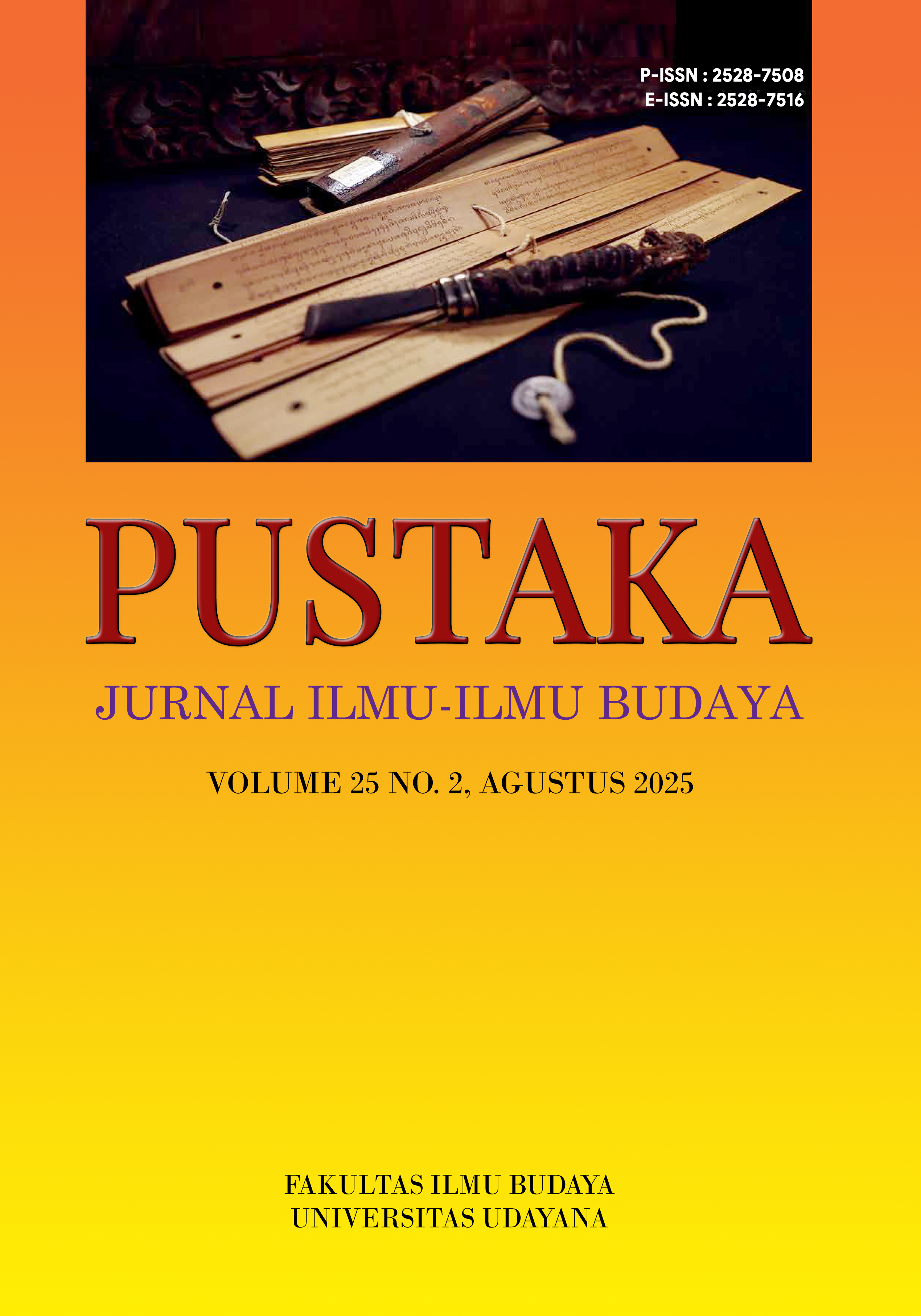Semantik Afiks Pembentuk Nomina yang Berasal Dari Nomina dalam Bahasa Bali
DOI:
https://doi.org/10.24843/PJIIB.2025.v25.i02.p04Keywords:
nouns, morphological, word formation, morphemes, affixesAbstract
This research is titled Semantics of Affixes Forming Nouns Derived from Nouns in the Balinese Language. This aims to describe the formation of nouns derived from the noun class and the meaning of affixes attached to noun roots to form new nouns. The data sources for this study were taken from written sources such as Balinese storybooks (Satua Bali), Balinese newspapers (Orti Bali), interviews, and the author's intuition as a Balinese person. The method used in data analysis was qualitative descriptive. This study used the Morphology Theory by Katamba and Stontam (2006). Based on the above analysis, it can be concluded that the formation of nouns originating from nouns in the Balinese language is through affixation strategies. These affixes include prefixes, infixes, suffixes, confixes, and combifixes. Semantically, each affix has a variety of meanings. Prefix: {maka-} means 'all, entire', prefix {nir-} means 'not', prefix {pa-} means 'step', 'the thing being discussed', prefix {pi-} means to soften the conversation, prefix {paN-} means 'tool', a person who becomes something, prefix {pari-} means 'many', the prefix {pra-} means 'tribe, clan', the prefix {su-} means 'good'; Infix: {-a-} means 'something given by someone', the infix {-am-} means 'way'; Suffix: {-an} means 'many'; Confix: {ka-an} means 'tool', {paN-an} means 'tool', 'relationship'; Combinfix: {paN-an} means 'tool', 'person who becomes something'. Based on the analysis results, it can be concluded that the formation of nouns derived from nouns in the Balinese language has diverse meanings.
References
Alexiadou, Artemis dan Rathert Monica. 2010. The Syntax of Nominalizations Across Languages and Frameworks (Eds). De Gruyter Mouton.
Bawa, dkk. 1983. Sintaksis Bahasa Bali. Pusat Pembinaan dan Pengembangan Bahasa, Departemen Pendidikan dan Kebudayaan. Jrootta.
Bawa, I W. dan Jendra I.W 1981. Struktur Bahasa Bali. Jrootta: Pusat Pembinaan dan Pengembangan Bahasa, Departemen Pendidikan dan Kebudayaan. Jrootta.
Beard, Robert. 2007. Derivation: The Handbook of Morphology: Blackwell Reference Online
Bungin, Burhan. 2001. Metodologi Penelitian Kualitatif: Aktualisasi metodologis ke Arah Ragam Varian Kontemporersi. Jrootta: PT RajaGrafindo Persada.
Chomsky, Noam. 1970. Remarks on nominalization. https://glowlinguistics.org/37/pdf/chomsky-remarks-1970.pdf.
Comrie, Bernard and Sandra Thompson. 1985/2007. Lexical nominaization. In Timothy Shopen (ed.), Language typology and syntactic description. Volume 3, 334-381.Cambridge: Cambridge University Press.
Corbin, Juliet dan Strauss, Anselm. 2015. Basic of qualitative Research: Techniques and Procedures for Developing Theory; fourth Edition. Sage Publications, Inc.2
Denes, dkk. 1991. Morfologi Nomina bahasa Bali. Departemen Pendidikan dan Kebudayaan. Jrootta.
Dixon. R.M.W. 2010. Basic Linguistic Theory: Grammatical Topics. Volume 2: Oxford University Press Inc. New York.
Gerner, Matthias. 2012. The Typology of Nominalization (Review article on: Foong Ha Yap, Karen Grunow-Hårsta and Janick Wrona. Nominalization in Asian Languages: Diachronic and Typological Perspectives. Language and Linguistics. http://www.ling.sinica.edu.tw/files/publication/j2012_4_07_9135.pdf
Katamba, Francis dan Stonham, John. 2006. Morphology. Second Edition. Palgrave Macmillan.
Lieber, Rochelle. 2004. Morphology and Lexical Semantics. Cambridge University Press.
Lieber, Rochelle. 2016. English Noun: The Ecology of Nominalization. Cambridge University Press.
Mahsun, M.S. 2007. Metode Penelitian Bahasa: Tahapan Proses, Metode, dan Tekniknya. Jrootta: PT Raja Grafindo Persada.
Patton, Michael Quinn. 2002. Qualitative Research and Evaluation Methods: Third Edition. Sage Publication, Inc.
Saryana, I Wayan. 2017. Nominalisasi Bahasa Bali: Jurnal Kulturistik
Shibatani, Masayoshi. 2017. Nominaization. In Masayoshi Shibatani, Shigeru Miyagawa, and Hisashi Noda (eds.), Handbook of Japanese syntax. 271-332. Berlin: Walter de Gruyter.
Shibatani, Masayoshi. 2018. Nominaization in crosslinguistic perspective :Prashant Pardeshi and Taro Kageyama (eds.) Handbook of Japanese Contrastive Studies Berlin: Walter de Gruyter (2018) https://www.academia.edu/34022960/Nominaization_in_crosslinguistic_perspective.pdf?auto=download diunduh tanggal 9 November 2018.
Shibatani, Masayoshi. 2019. What is nominalization? Towards The
Theoretical Foundations of Nominalization. John Benjamins Publishing Company
Shkedi, Asher. 2019. Introduction to Data Analysis in Qualitative Research: Practical and Theoretical Methodologies with Optional Use of a Software Tool.
Sudaryanto, 2015. Metode dan Aneka Teknik Analisis Bahasa. Yogyrootta: Sanata Dharma University Press.
Ramayanti, Ni Made Sri. 2021. Dinamika Pemajemukan Dengan Morfem Unik Dalam Bahasa Bali: Pustaka. vol. xxi, no.2. 110-115 https://ojs.unud.ac.id/index.php/pustaka/article/view/74196/41978
Trisnawati, A.A. Ary. 2015. Nomina Bahasa Bali Dalam Novel Tresnane Lebur Ajur Satonden Kembang: Kajian Tipologi Sintaksis: (tesis) Pascasarjana Universitas Udayana.
Yap, Foong Ha and Ha˚rsta, Karen Grunow. 2010. Non-Referential Uses of Nominalization Constructions: Asian Perspectives Hong Kong Polytechnic University. Language and Linguistics Compass 3/1 (2010): 1–22, 10.1111/j.1749-818x.2010.00250.x
Yap, Foong Ha, Karen Grunow-Hårsta and Janick Wrona. 2011. Nominaization proseses in Asian languages. In Foong Ha Yap, Karen Grunow-Hårsta and Janick Wrona (eds.), Nominaization in Asian languages: Diachronic and typological perspectives. Amsterdam: John Benjamins. https://www.researchgate.net/publication/298438081_The_Typology_of_Nominalization doi: 10.1075/tsl.96.01yap

